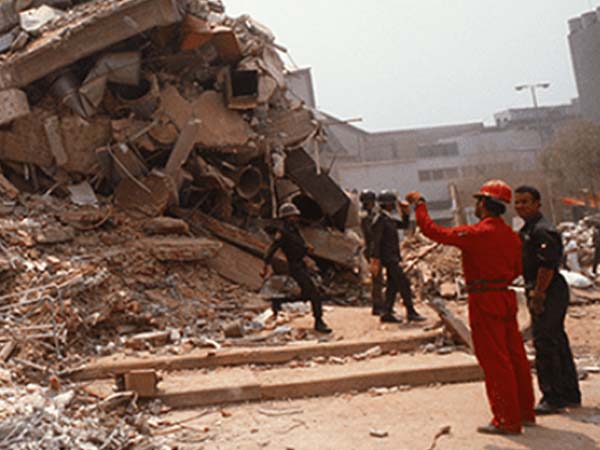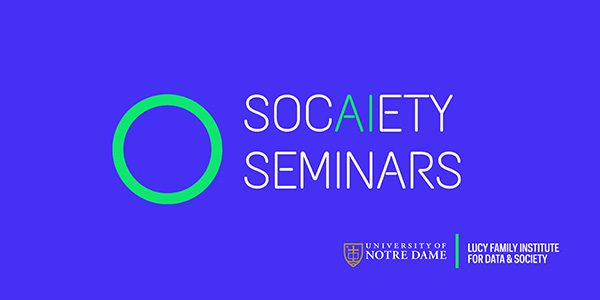A Personal Vendetta against Cancer: Cancer survivor builds tissue bank for Harper research
Toni Page-Mayberry vividly recalls the start of her meeting in 2014 with an oncologist about her husband’s cancer diagnosis. The doctor sat them down and said Jay had stage 4 brain cancer and only about three months to live.
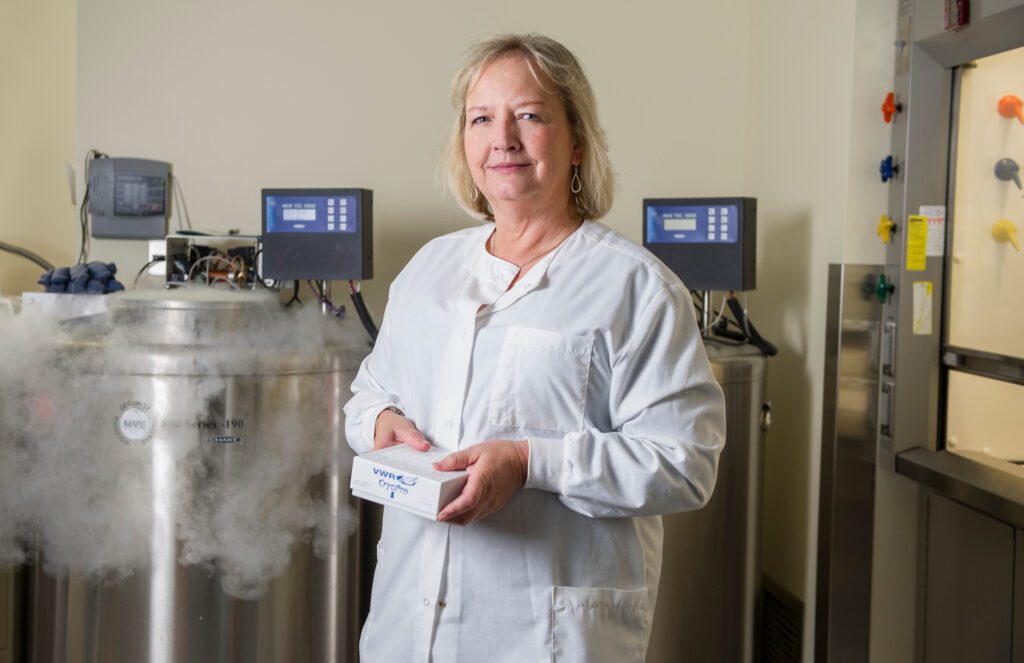
After that, everything else the doctor said sounded to her like Charlie Brown’s teacher: mwaw-mwaw-mwaw. The hospital room became a blur.
Page-Mayberry had been there before. She took care of her mother before she died of breast cancer in 2001. A year later, she was diagnosed with breast cancer herself.
Radiation treatment made Jay so weak that he needed an airplane pillow to hold up his head, so nauseous that Toni learned to keep a towel in the car and drive in the right lane so they could pull over quickly. Chemotherapy helped him live another year and a half. By the end, she was setting her alarm for every three hours to give him pain medication.
“I tell patients I’m one pissed-off woman. I’m very passionate about what I do. I have a personal vendetta against cancer.“Toni Page-Mayberry
“It was a nightmare,” Page-Mayberrry said. “I tell patients I’m one pissed-off woman. I’m very passionate about what I do. I have a personal vendetta against cancer.”
These days, Page-Mayberry funnels that passion into her job as the tissue bank consent coordinator for the Mike and Josie Harper Cancer Research Institute at Notre Dame. Her mission is to get as many patients as possible to sign a consent form to share their leftover tumor samples with Harper so that the cancer specialists there can do breakthrough research that leads to a cure.
Page-Mayberry said the doctors at Harper were instrumental in giving her peace of mind that Jay got the best care a cancer patient could have. “It’s a close-knit group – the people at Harper knew him,” she said. “They understand why I’m the crazy cancer lady.”
She is often the first person a cancer patient sees after checking in at the local hospitals for their 5 a.m. surgery. She explains that their doctor works with Harper, and that real tissue samples are how research will find a cure. Sometimes, she shares her own experience and a warm hug.
“I have to read the patients and how they are reacting, as well as find a way to fit into the rhythm of the nurses and doctors prepping them for surgery,” she said. “It’s like jumping into a moving jump rope and then jumping back out.”
Most tissue banks are built in teaching hospitals connected to a university. It’s standard care in those places to include a consent form for every patient. Harper does not have that luxury; it may be the only nonprofit community-based tissue bank in the country. Page-Mayberry is the point person for convincing people to voluntarily donate a little part of themselves, literally.
When she started in 2013, Harper’s tissue bank worked with four surgeons and had 185 patient donors. The program now has more than 1,000 patient consents and works with 30 area doctors. Page-Mayberry holds meetings, attends conferences, gives presentations, trains nurses in how to process samples – anything to get the word out that Notre Dame is doing cutting-edge cancer research despite not having a medical school.
Projects investigating breast, colorectal, ovarian and oral cancer are currently using samples from the tissue bank in their research, including that of biochemist Sharon Stack, the institute’s Ann F. Dunne and Elizabeth Riley Director. When Stack came to lead the new facility in 2011, she brought a strategy of bringing scientists from diverse fields together in teams that study the causes and processes of different types of cancer and how they metastasize.
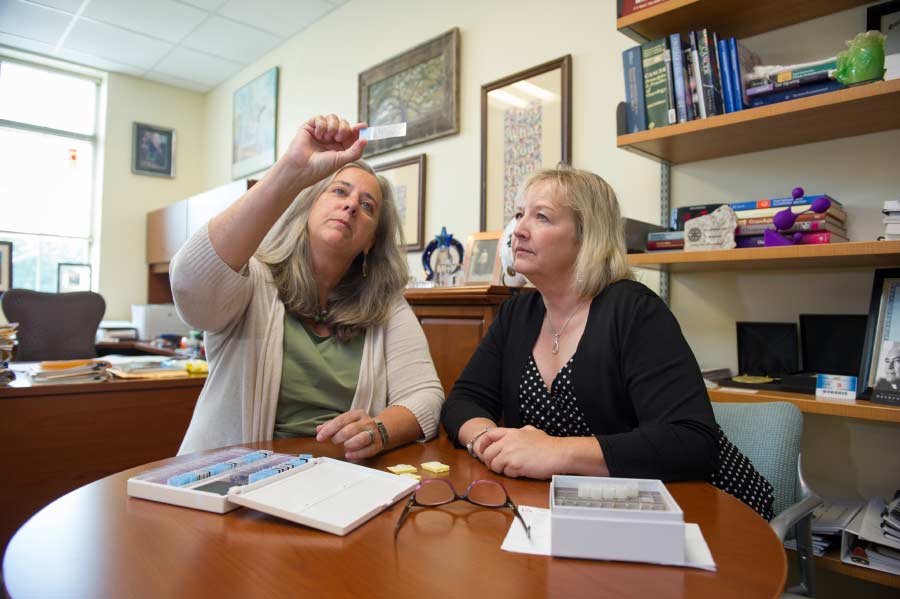
For instance, Stack works with engineer Hsueh-Chia Chang, whose work in nanofluidics and electrokinetic detection was far outside her area of expertise. Stack had discovered early indicators for oral cancers related to the human papillomavirus (HPV) and Chang built instruments in need of more medical applications. Their collaboration could lead to early detection of HPV in a dentist’s office.
“The importance of this resource can’t be overstated,” Stack said of the difficult process of building a tissue bank. “We can do experiments in cells and in mice all day long, and that is a great starting point. But it’s essential to ensure that the process or molecule under investigation is actually present in human tumors to assure translational relevance.”
This kind of research motivates Page-Mayberry. She grew up in Niles, Mich., and worked as a medical technologist at the South Bend Medical Foundation and South Bend Clinic for nearly a dozen years. She figures that stint on the clinical side got her the job, because she acts as the bridge between the hospital and research communities.
She has experience in microbiology, blood cultures, toxicology and other lab tech areas, and has taught classes in chemistry and medical terminology at National College, a community college that offers training for medical assistants and pharmacy techs in South Bend.
She witnessed her mother’s 13-year battle with cancer, going through radiation and chemotherapy three times. Her mother continued her studies to become a teacher despite severe sickness. Page-Mayberry said her body was so burned by radiation that the undertaker asked what had been done to her.
A year later, when her doctor called at 6:30 on a Friday night, she knew the news had to be bad. She insisted on a double mastectomy after seeing the cancer return in her mother. A few years earlier, Page-Mayberry had found a quarter-size mole on her husband’s neck that turned out to be melanoma. Both were in remission as their family of her three daughters and his two daughters grew to 11 grandkids.
Page-Mayberry heard Sharon Stack talk as a guest speaker at a breast cancer survivor luncheon and decided she wanted to work for someone as passionate as herself. The grants for the tissue bank, including salaries and nearly $1 million in equipment, took two years to accumulate. Page-Mayberry has since set her sights on growing the sample size to more than 3,000 patients.
“Tissue banking is how we’ll find the cure.”
“Tissue banking is how we’ll find the cure,” she tells patients and medical professionals alike.
The lab techs at St. Joseph Regional Medical Center and Memorial Hospital in South Bend preserve the samples, which come from tissue that is leftover after performing various screening tests or surgeries. The samples must be placed in a preservative solution called RNAlater and carefully labeled, which is extra work in an already hectic schedule.
Page-Mayberry or her lab technician Laura Tarwater pick up the samples and perform a de-identification process. They remove the RNA, weigh the samples, give them Harper number codes and store them in a special freezer at 85 degrees below zero. Fresh samples not preserved in RNA must be flash frozen in liquid nitrogen at 190 degrees below zero.
A growing tissue bank means that a broad sample size improves the quality and validity of the research. Each research lab at Harper and the adjacent Indiana University School of Medicine must go through the Institutional Review Board and a Harper review committee to prove the validity of their study before they can obtain tissue samples. There is no charge to the labs, which can then preserve their grant money for the actual research.
Another benefit to Harper having its own tissue bank is that its availability can be a draw for top graduate students and professors interested in cancer research. Stack said tissue donation also “provides an empowering experience to some patients facing a potentially difficult diagnosis to know that they can actively participate in important biomedical research.”
Page-Mayberry has aggressive goals. She made a button that says “Get Mad. Fight Back” and wrote to Vice President Joe Biden to offer the slogan for his national initiative to find a cure. She wants the tissue bank consent form to become part of standard care nationwide.
“The long goal is to become a benchmark for other communities,” she said, because about 80 percent of cancer patients do not receive care from a teaching hospital and therefore are not represented in tissue banks.
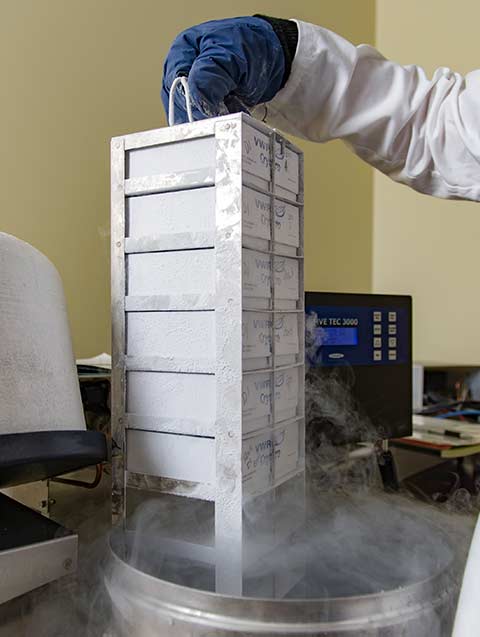
In these efforts, which are as much marketing as science, Page-Mayberry draws on her theatrical experience. Since she was 15, she has been involved in theater as an actress, director, choreographer or costume maker, including local companies in the Michigan cities of Dowagiac, Benton Harbor and Buchanan.
She and her late husband were a team, with Jay involved in technical aspects like lighting, sound and stage scenery. Getting back into theater without him has been hard, she said, but friends have pulled her back into a local production of To Kill a Mockingbird. And sometimes, it helps to know she’s making a difference.
She is dedicated to her job “because she has been in that room herself, both as a patient and a caregiver,” Stack said. “Toni hates cancer for a reason and she is working extremely hard to provide an essential resource to help Harper’s research teams eradicate it.”
Produced by the Office of Public Affairs and Communications
- Author: Brendan O’Shaughnessy
- Photography: Barbara Johnston
January 18, 2024

